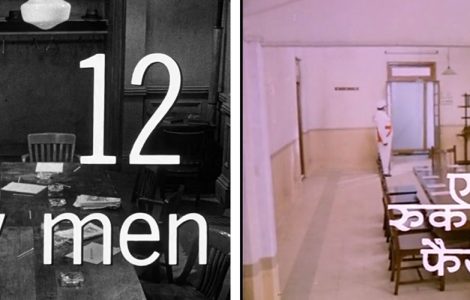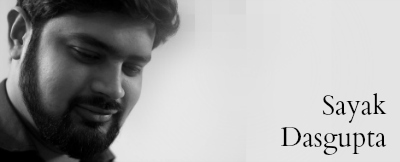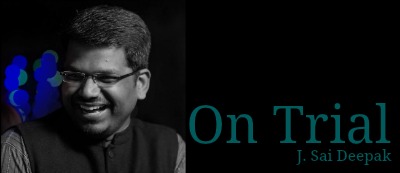 In 1973, a boy named Kevin Edward Noonan took his high school sweetheart to watch a screening of a 1957 movie. She had just earned a full scholarship to Princeton and was considering going to law school in the future. Perhaps he hoped that watching a classic legal drama would inspire her. And it did. She was especially moved by a scene at around the hour mark in which an immigrant speaks about the greatness of the American judicial system. “This, I have always thought, is a remarkable thing about democracy,” he says. “That we are… what is the word? Notified! That we are notified by mail to come down to this place to decide on the guilt or innocence of a man we have never heard of before. We have nothing to gain or lose by our verdict. This is one of the reasons why we are strong.” The young girl, whose only legal inspiration till then had been Perry Mason, was blown away. “I had never thought about the juries and their function until I saw this movie,” she later said. “This was my very first inspiration. When the watchmaker in that scene talked about the greatness of democracy being the jury system? It sold me.” The movie was 12 Angry Men, and the girl was Sonia Sotomayor, the first Latina to become a judge at the Supreme Court of the United States.
In 1973, a boy named Kevin Edward Noonan took his high school sweetheart to watch a screening of a 1957 movie. She had just earned a full scholarship to Princeton and was considering going to law school in the future. Perhaps he hoped that watching a classic legal drama would inspire her. And it did. She was especially moved by a scene at around the hour mark in which an immigrant speaks about the greatness of the American judicial system. “This, I have always thought, is a remarkable thing about democracy,” he says. “That we are… what is the word? Notified! That we are notified by mail to come down to this place to decide on the guilt or innocence of a man we have never heard of before. We have nothing to gain or lose by our verdict. This is one of the reasons why we are strong.” The young girl, whose only legal inspiration till then had been Perry Mason, was blown away. “I had never thought about the juries and their function until I saw this movie,” she later said. “This was my very first inspiration. When the watchmaker in that scene talked about the greatness of democracy being the jury system? It sold me.” The movie was 12 Angry Men, and the girl was Sonia Sotomayor, the first Latina to become a judge at the Supreme Court of the United States.
The Origin Story
12 Angry Men was originally written as a fifty-minute teleplay in 1954 by Reginald Rose, one of a group of bright, socially-conscious up-and-coming screenwriters of the ‘50s – a decade known as the golden age of television drama in the US (much like the present decade) – that included such legends as Rod Serling and Paddy Chayefsky. Rose was inspired by his own experience of jury duty on a manslaughter case in New York City. Initially, he had been reluctant to serve on a jury, but, as he wrote later: “the moment I walked into the courtroom… and found myself facing a strange man whose fate was suddenly more or less in my hands, my entire attitude changed.” The gravity of the situation, the sombre activity of the court, and the “absolute finality” of the decision of the jurors made a deep impact on him. He felt that since no one other than the jurors had any idea of what went on in a jury room, “a play taking place entirely within a jury room might be an exciting and possibly moving experience for an audience”.

Opening pages of the stage play book
The result was a taut, gripping story about a jury that must decide the fate of a young Hispanic boy who has been accused of murdering his father. Eleven of the jurors believe that he is guilty, but only one man is unconvinced, and what proceeds is a tense debate on the facts of the case, a dismantling of all the ostensibly damning evidence, and also an airing of social stigmas and ingrained prejudices. A play written in the ‘50s will obviously have its attendant problems of representation; it might as well have been called “12 Straight White Men”. There are no women or persons of colour in the jury. But the plot allows for a range of characters fitting various archetypes. This becomes especially clear from the notes on characters and costumes in the stage play adaptation. Juror No. 2 is “a meek, hesitant man who finds it difficult to maintain any opinions of his own,” whereas Juror No. 3 is “very strong, forceful, extremely opinionated […] intolerant of opinions other than his own, and accustomed to forcing his wishes and views upon others.” Juror No. 7 is “a loud, flashy, glad-handed salesman type who has more important things to do than sit on a jury,” and is, basically “a bully, and, of course, a coward”, whereas Juror No. 11 “is a refugee from Europe […] who speaks with an accent and is ashamed, humble, almost subservient to the people around him.” There is the “man of wealth and position” who feels “a little bit above the rest of the jurors and whose “only concern is with the facts in the case”, and there is a “slick, bright advertising man who thinks of human beings in terms of percentages, graphs and polls”. Our hero, Juror No. 8 is a “quiet, thoughtful, gentle man”, a man “who wants justice to be done, and will fight to see that it is.” In other words, he is a lone warrior fighting an uphill battle against a room full of men opposed to him; an underdog fighting for another underdog. These are all tried and tested archetypes and they work really well.
Film Adaptations
The teleplay was adapted into a film directed by Sidney Lumet and starring Henry Fonda. Although the film didn’t fair very well at the box office, it gained almost universal critical acclaim, and is considered one of the most influential films ever made. The American Film Institute ranked it second in its list of the top 10 courtroom dramas of all time, just behind To Kill A Mockingbird (1962), an interesting decision given that an actual courtroom only appears in the film for less than 2 minutes; the rest of the film’s 96-minute running time plays out in an increasingly claustrophobic jury deliberation room. But there is no doubting its influence. It was remade as a television film forty years later by acclaimed director William Friedkin starring George C. Scott, Jack Lemmon and James Gandolfini. In fact, it has been repeatedly remade in various languages in various countries around the world, including Germany, Norway, Japan, Russia, France, China and, of course, India, despite the fact that most of these countries do not even have a judicial system that mandates jury trials.

The Indian version, Ek Ruka Hua Faisla, directed by Basu Chatterjee and starring Pankaj Kapur, M.K. Raina and Annu Kapoor was made in 1986. At a run time of 127 minutes, it is half-an-hour longer than the original, but is a more-or-less faithful translation. And I do mean that quite literally. The jurors have the same personalities and even correspond to the same numbers as in the original. Many of the dialogues are direct Hindustani translations of the original English lines. Even some of the jokes are repeated. The racism and prejudice against Hispanics, immigrants and slum-dwellers displayed by some of the jurors in 12 Angry Men have been cleverly reflected in Ek Ruka Hua Faisla as upper-caste bigotry against minorities and the rising hatred for South Indian immigrants in Bombay that was being fuelled by right-wing groups at the time.

Scenes from 12 Angry Men (left) and Ek Ruka Hua Faisla (right)
The Jury Is Still Out
But the thing to note here is that by 1986, the jury trial was long dead in India. There is nothing in the film to suggest that it is a period film based in the ‘50s when jury trials still happened, and yet there is no explanation for a jury in this case. In the Chinese adaptation, 12 Citizens (2014), the twelve men are assembled from different walks of life to form a mock jury as part of an experiment in a law school, a set-up that makes sense. As we had discussed in our video on the Nanavati trial earlier this year, the East India Company had introduced the jury trial in India as Englishmen considered it their right to be judged by a jury of their peers. However, even under the British Raj, English lawyers felt that Indians did not make good jurors as they were deemed to be irrational, swayed by superstition and religion and incapable of understanding the English language in which court proceedings were conducted. Various law commission reports suggested the abolition of the jury trial, the final one being the 41st Law Commission Report published in 1969. The Nanavati case is widely regarded as the nail in the coffin of the jury trial, which was done away with in the Code of Criminal Procedure, 1973.

Justice Y.V. Chandrachud (Image from supremecourtofindia.nic.in)
The public prosecutor in the Nanavati trial was Y.V. Chandrachud, who would go on to become the Chief Justice of India. It was during his tenure as Chief Justice that he was a part of the five-judge bench that presided over the landmark case of Bachan Singh vs. State of Punjab AIR 1980 SC 898, in which he and three of his brother judges upheld the validity of the death sentence under Section 302 of the Indian Penal Code, 1860. The only dissenting voice was that of Justice Bhagwati who felt that the death penalty was unconstitutional. However, the most important aspect of the judgment was the court’s pronouncement that the death penalty should only be given in the “rarest of rare cases”. In Ek Ruka Hua Faisla as in 12 Angry Men, the judge tells the jurors that if they found the accused guilty, he would be automatically sentenced to death. While this certainly raises the stakes in the films and makes the decision far more difficult, one wonders if a boy would be sentenced to death in India for killing his violent, abusive father keeping in mind the fact that there have been only 56 death penalty cases in Maharashtra since 1947. There are other basic inaccuracies that a layman might miss, but are glaring errors for lawyers who are familiar with the jury system. For example, in Ek Ruka Hua Faisla, one of the jurors is shown casually reading a newspaper just before deliberations begin. Anyone who is familiar with jury trials knows that jurors are completely sequestered during the pendency of the trial and are denied access to newspapers, television and any form of mass media in order to keep them absolutely unbiased. Similarly, while I am not an expert in American criminal law, it seemed improper of the judge in 12 Angry Men to tell the jury that a guilty verdict would necessarily attract the death penalty. It is my understanding that once the jury has given its verdict the judge sets a date for sentencing. Before that date, a pre-sentence investigation is carried out to help the judge determine the appropriate sentence. The pre-sentence investigation may consider the defendant’s prior criminal record, background, possible mitigating circumstances of the crime, the likelihood of successful probationary sentence, and suggested programmes for rehabilitation. It seems a little presumptuous of the judge to offer a foregone conclusion to the jurors before any of this has been done.
Flawed Greatness

Official Portrait of Justice Sonia Sotomayor
But ultimately, there is no point in getting hung up on legal inaccuracies in a film, where the aim is to build tension and keep the audience engaged. While all the characters in the films are interesting, arguably the most important character is mostly invisible: the court. And while 12 Angry Men is a great film that had a positive impact on many people, it is not without its flaws. Justice Sotomayor, who counts the film among her major inspirations, admitted that, as a lower-court judge, she referred to it to instruct jurors on how not to carry out their duties. While speaking about the film in Fordham University in 2010, she said: “I would bring up this movie and explain to them that some of the things that happened, shouldn’t have happened. There’s an awful lot of speculation in the film.” The courtroom proceedings in the film are portrayed as a complete shambles. The defence attorney is described as incompetent and uninterested in the case. However, Sotomayor went further and also criticised the unseen prosecutor, stating that the job of the prosecutor is not merely to convict people, but also to investigate thoroughly beforehand to ensure the defendant’s guilt.

Scenes from 12 Angry Men (left) and Ek Ruka Hua Faisla (right)
Like many other films based on the law, 12 Angry Men is suspicious of the judicial system and reposes more faith in the efforts and ingenuity of one bright individual warrior for the cause of truth. The largely absent courtroom in the film is cast less as a facilitator of justice and more as a hindrance, where lazy, bored and cynical officers of the court do a shoddy job of conducting a trial, subverting the judicial process, making it a farcical exercise. Rather than bringing some clarity to the case, the courtroom manages to mislead all but one man, making it the largest red herring in the history of crime. The twelve men, it would seem, have every right to be angry.

 A few years ago, I had read an article about the peculiar social and cultural differences between Japan and the west. It was written by an American man who had married a Japanese woman and settled down in Tokyo. He wrote of an incident when his parents-in-law had come to eat dinner. As they entered, the writer, as a matter of habit, proceeded to help his mother-in-law take her coat off and put it on the coat rack. He then realised that his father-in-law had not taken too kindly to that rather innocent act. The writer’s wife told him later that while taking your guest’s coat was a gesture of polite hospitality in the west, in Japan it was an act of deep intimacy – one only husbands can do for their wives. When it comes to love, the Japanese are culturally not as flamboyant, effusive and demonstrative as the Americans or Europeans (the Japanese millennial might be more westernised, but this seemingly still holds true for most of Japan). They don’t hug and kiss each other all the time. They don’t say “I love you” at the end of every conversation. Instead, the Japanese show their affection for their spouses and even their children through a hundred small acts that demonstrate caring and intimacy. This restrained, understated form of love might seem strange and even silly to westerners, but that doesn’t make it any less valid. In fact, it has its own charm and beauty.
A few years ago, I had read an article about the peculiar social and cultural differences between Japan and the west. It was written by an American man who had married a Japanese woman and settled down in Tokyo. He wrote of an incident when his parents-in-law had come to eat dinner. As they entered, the writer, as a matter of habit, proceeded to help his mother-in-law take her coat off and put it on the coat rack. He then realised that his father-in-law had not taken too kindly to that rather innocent act. The writer’s wife told him later that while taking your guest’s coat was a gesture of polite hospitality in the west, in Japan it was an act of deep intimacy – one only husbands can do for their wives. When it comes to love, the Japanese are culturally not as flamboyant, effusive and demonstrative as the Americans or Europeans (the Japanese millennial might be more westernised, but this seemingly still holds true for most of Japan). They don’t hug and kiss each other all the time. They don’t say “I love you” at the end of every conversation. Instead, the Japanese show their affection for their spouses and even their children through a hundred small acts that demonstrate caring and intimacy. This restrained, understated form of love might seem strange and even silly to westerners, but that doesn’t make it any less valid. In fact, it has its own charm and beauty.





